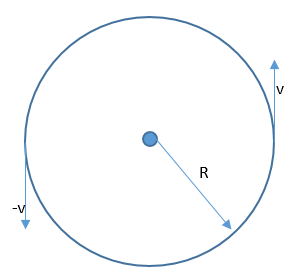
If a particle covers half the circle of radius R with constant speed then,
A. Momentum change is \[mvr\]
B. Change in K.E. is\[\dfrac{1}{2}m{v^2}\]
C. Change in K.E. is \[m{v^2}\]
D. Change in K.E. is zero
Answer
217.8k+ views
Hint:The momentum is a vector quantity and has direction and magnitude. It is the product of the mass of the particle and velocity.
Formula used:
\[\overrightarrow p = m\overrightarrow v \]
Here \[\overrightarrow p \]is the momentum of the particle of mass m and moving with velocity \[\overrightarrow v \]
\[K.E. = \dfrac{1}{2}m{v^2}\]
Here K.E. is the kinetic energy of the particle of mass m and speed v.
Complete step by step solution:

Image: Particle in the circle of radius R
Let the constant speed of the particle is v and it starts from position velocity pointing upward. Then after completing half revolution around the circle of radius R, the velocity vector will be downward. So, the change in momentum will be the difference between the final momentum to the initial momentum,
\[\Delta p = {p_f} - {p_i}\]
\[\Rightarrow \Delta p = - mv - mv\]
\[\Rightarrow \Delta p = - 2mv\]
So, the momentum change is not equal to mvr
The change in kinetic energy of the particle will be the difference between the final kinetic energy to the initial kinetic energy. The initial kinetic energy of the particle is,
\[{K_i} = \dfrac{1}{2}m{v^2}\]
The final kinetic energy of the particle is,
\[{K_f} = \dfrac{1}{2}m{v^2}\]
So, the change in kinetic energy of the particle is,
\[\Delta K = {K_f} - {K_i}\]
\[\Rightarrow \Delta K = \dfrac{1}{2}m{v^2} - \dfrac{1}{2}m{v^2}\]
\[\therefore \Delta K = 0\]
Hence, the change in kinetic energy of the particle moving in the circular path is zero.
Therefore, the correct option is D.
Note: As the speed of the particle is constant so there is no acceleration acting on it. So, the net force acting on the particle is zero. As there is no force acting on it so the work done also is zero. Using the work-energy theorem, the change in kinetic energy is the work done on it. So, the change in kinetic energy of the particle is zero.
Formula used:
\[\overrightarrow p = m\overrightarrow v \]
Here \[\overrightarrow p \]is the momentum of the particle of mass m and moving with velocity \[\overrightarrow v \]
\[K.E. = \dfrac{1}{2}m{v^2}\]
Here K.E. is the kinetic energy of the particle of mass m and speed v.
Complete step by step solution:

Image: Particle in the circle of radius R
Let the constant speed of the particle is v and it starts from position velocity pointing upward. Then after completing half revolution around the circle of radius R, the velocity vector will be downward. So, the change in momentum will be the difference between the final momentum to the initial momentum,
\[\Delta p = {p_f} - {p_i}\]
\[\Rightarrow \Delta p = - mv - mv\]
\[\Rightarrow \Delta p = - 2mv\]
So, the momentum change is not equal to mvr
The change in kinetic energy of the particle will be the difference between the final kinetic energy to the initial kinetic energy. The initial kinetic energy of the particle is,
\[{K_i} = \dfrac{1}{2}m{v^2}\]
The final kinetic energy of the particle is,
\[{K_f} = \dfrac{1}{2}m{v^2}\]
So, the change in kinetic energy of the particle is,
\[\Delta K = {K_f} - {K_i}\]
\[\Rightarrow \Delta K = \dfrac{1}{2}m{v^2} - \dfrac{1}{2}m{v^2}\]
\[\therefore \Delta K = 0\]
Hence, the change in kinetic energy of the particle moving in the circular path is zero.
Therefore, the correct option is D.
Note: As the speed of the particle is constant so there is no acceleration acting on it. So, the net force acting on the particle is zero. As there is no force acting on it so the work done also is zero. Using the work-energy theorem, the change in kinetic energy is the work done on it. So, the change in kinetic energy of the particle is zero.
Recently Updated Pages
Arithmetic, Geometric & Harmonic Progressions Explained

Cartesian Form of Vector Explained: Formula, Examples & Uses

Apparent Frequency Explained: Formula, Uses & Examples

Calorimetry: Definition, Principles & Calculations

Centrifugal Force Explained: Definition, Formula & Examples

Charge in a Magnetic Field: Definition, Formula & Examples

Trending doubts
JEE Main 2026: Application Form Open, Exam Dates, Syllabus, Eligibility & Question Papers

Derivation of Equation of Trajectory Explained for Students

Hybridisation in Chemistry – Concept, Types & Applications

Understanding the Angle of Deviation in a Prism

Understanding Collisions: Types and Examples for Students

Understanding Atomic Structure for Beginners

Other Pages
JEE Advanced Marks vs Ranks 2025: Understanding Category-wise Qualifying Marks and Previous Year Cut-offs

Units And Measurements Class 11 Physics Chapter 1 CBSE Notes - 2025-26

NCERT Solutions For Class 11 Physics Chapter 8 Mechanical Properties Of Solids

Motion in a Straight Line Class 11 Physics Chapter 2 CBSE Notes - 2025-26

NCERT Solutions for Class 11 Physics Chapter 7 Gravitation 2025-26

How to Convert a Galvanometer into an Ammeter or Voltmeter




